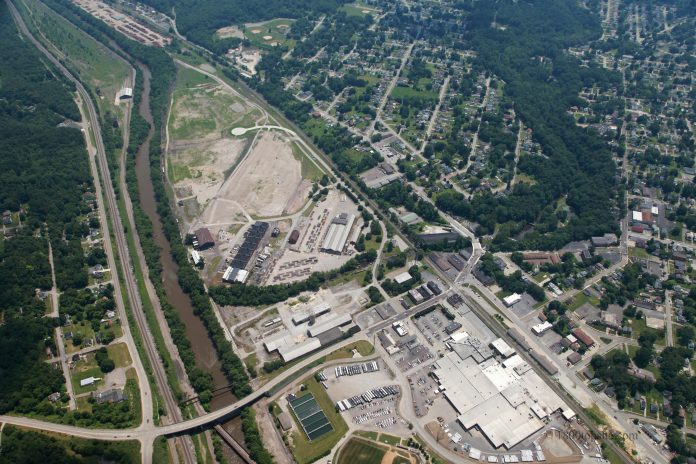
Editor’s note: Holly Burnett’s article was originally published in Dec. 2000.
Throughout most of the last century, the Mahoning River was an indispensable tool in the making of steel. The mills drew the water out of the river, cooling the brutally hot metal and machinery, and poured the scalding water straight back in, along with thousands of pounds of toxins every day. In 1977, the river received nearly half a million pounds per day of steel mill waste in the form of oil and grease, ammonia-nitrogen, zinc, cyanide and suspended solids.
Most of it washed down the river, but some of that toxic material remains imbedded in the riverbed and some of the banks from Warren to Lowellville, warranting a contact ban on the mainstream of the river.
The upper parts of the river, on the other hand, are in relatively good condition, even pristine in some areas. Streams like Eagle Creek, Yellow Creek, Mill Creek and West Branch, along with the five reservoirs – Meander, Mosquito, Milton, Berlin and Kerwin – were not deeply affected by the pollution and afford recreational resources for the Mahoning Valley.
Local governments created the reservoirs to provide sources of clean drinking water because, in large part, the Mahoning River was becoming more polluted, but also to prevent floods, help flush the toxins, and supply ready water to keep the mills running continually during World War II.
There are plans to dredge the Mahoning River from Warren to Lowellville. Dredging would involve removing the toxic sediment and replacing it with clean stones and pebbles. The dredging project is about to go into the feasibility phase and is being promoted by the U.S. Army Corps of Engineers, the U.S. and Ohio Environmental Protection Agencies, and Youngstown State University, as well as other local groups such as the Mahoning River Consortium.
The feasibility study to determine how the dredging should be done will take 18 months. After that, once funds are raised – projected to be $70 million to $100 million – the actual dredging will begin.
This, of course, will mark a new beginning for a river that served its duty in building a community, providing jobs for thousands of residents and helping to win a World War by supplying 15 percent of the nation’s steel. This time around, an opportunity exists to redevelop the river in a responsible manner.
The health of the river is better than it has been in a century (with the steel mills closing and with enforcement of EPA regulations) and should improve profoundly with the dredging. However, there remain sources of pollution coming from industry and sewage treatment (called “point source of pollution” because you can find the pipe or point where the toxins enter the river), from toxic runoff of pesticides and herbicides from lawns (straight down the storm sewer to the river) and from farming (called “non-point source of pollution” because once it’s in the river, there’s no way to determine its source). So, although the river is cleaner, much work remains.
The good news is the large quantity of vacant land along the river (once inhabited by steel mills) that can be reinvented to improve quality of life and economic development. Other communities, like Cleveland and Pittsburgh, have made the river an integral part of the revitalization of their cities.
Another positive is that the river still has much of its riparian zone still intact. The riparian zone is another phrase for the banks of the river, but can include up to 400 feet out from the river’s edge.
For a waterway so relentlessly polluted by heavy industry, the Mahoning River’s riparian zone is in remarkably good condition. This is good news: the trees in the riparian zone aid the health of the river by cooling the water in summer, providing habitat for wildlife, serving as a buffer against pollution, and preventing erosion. (Erosion allows silt and mud to upset the balance of the river’s interior ecosystem.)
There are at least 10 downtowns in Trumbull and Mahoning counties that are river communities: Youngstown, Warren, Niles, Campbell, Struthers, Girard, Newton Falls, Leavittsburg, McDonald and Lowellville. These cities have a unrivaled opportunity to plan individually as well as collectively to redevelop their downtown riverfronts, and to connect their communities with each other with the common thread of the river via a park system, bike-and-hike trails and other countless possibilities.
Inspiration can come from other nearby communities now planning collectively. The Ohio Canal Corridor Project starts in downtown Cleveland and threads through the Cuyahoga National Forest, continues through Akron and down to New Philadelphia. Features include a bike and walking trail, as well as the Cuyahoga Scenic Railroad. The communities are giving further meaning to this corridor by inviting visitors to historic destinations along the trail.
Something similar already is in the works – the Great Ohio Lake-to-River Greenway that will run from Ashtabula to East Liverpool, and will tie into a Mahoning River corridor trail that will start in Warren and connect to the already existing Stavich Trail that runs along the river from Struthers to New Castle, Pa.
A further development for the river is coming from an EPA sustainable land development grant through YSU starting next year. The goal of the grant is to facilitate long-term sustainable planning in river communities in Trumbull and Mahoning counties.
Simultaneously, programming is being completed that will help to educate the community at large about the Mahoning River and its possibilities. This will be available to schools and community organizations by fall of 2001 and will include videos, brochures and an interactive website.
Untapped resources like the Mahoning River are sleeping giants of economic development and quality of life. It takes long-term, collective planning by communities, inspiration from the successes of other river communities, and a desire to strike a healthy balance that respects all aspects of life together in community: respect for the most essential elements – the land and water, wildlife, industry, commerce, traffic, public green space and the folks who live here. These are all components of sustainable planning, and besides bringing good things to current life together, also look toward future generations who will inherit the fruits of the plans put in motion today.
Editor’s note: Over the past two years, Holly Burnett has been creating curricular resources about the Mahoning River. When completed, they will include two videos (one for upper elementary and middle school, one for senior high schools and adults), two brochures, posters, a game/puzzle, project ideas for teachers, public service announcements, and an interactive website. These will be completed by the fall of 2001, and will be available to public and private schools, any interested community groups, candidates, and public officials. Burnett is already working on a second set of curricular resources focused on “Downtown Revitalization, Urban Sprawl and Farmland Preservation in the Mahoning Valley.”
Metro Monthly is a local news and events magazine based in Youngstown, Ohio. We circulate throughout the Mahoning Valley and offer print and online editions. Be sure to visit our publication’s website for news, features, and community events. Office: 330-259-0435.
© 2017 Metro Monthly. All rights reserved.




